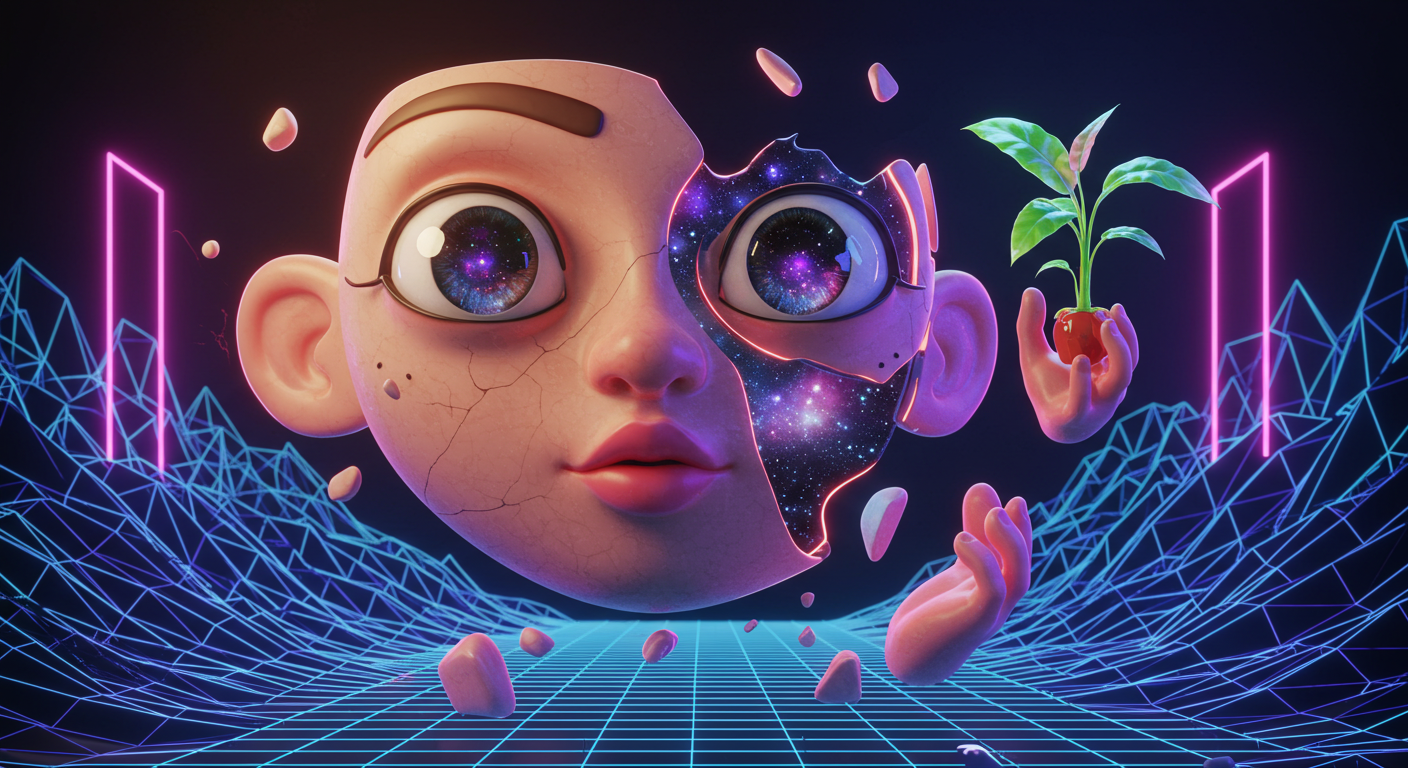Have you ever scrolled through your social media feeds and felt like your online persona is a remixed and slightly surreal version of your real self? If so, you’re not alone. In fact, there’s an entire digital art trend that captures this exact feeling and turns it into creative expression.
You may have seen it bubbling up on platforms like Instagram, Behance, or in discussions about NFTs. The buzzword for this wild new style is caricatronchi. It might sound strange at first, but it represents one of the most exciting intersections of art, technology, and personal identity today.
In this guide, we’ll break down exactly what caricatronchi is, explore the powerful cultural and tech forces driving its popularity, and even show you how you can create your very own piece of this surrealist art movement.
Understanding Caricatronchi
What Does the Name Mean?
So, what is this strange new word you’re seeing online? At its core, caricatronchi is a new genre of digital art that blends the familiar, humorous exaggeration of caricature with the dreamlike qualities of surrealism and anatomical fragmentation in striking visual form.
Let’s break that down. Imagine a cartoon portrait, but instead of just having a big nose, the subject’s body is deconstructed into symbolic pieces, floating in a digital landscape filled with metaphor. It’s part cartoon, part modern sculpture, and part digital dream. The name itself gives us a clue, as it’s a portmanteau of two words: “caricature,” the art of exaggeration, and “tronchi,” the Italian word for trunks or fragments, evoking themes of division and symbolism.
Beyond Humor: The Deeper Purpose
In contrast to a traditional caricature you might get drawn at a street fair, which is designed primarily for humor or satire, the goal of caricatronchi is much deeper and more introspective. Artists in this genre aim to create a visual representation of a person’s inner world and hidden layers. Therefore, they use fragmentation and symbolism to tell a story about identity, emotion, and personal experience in our complex digital age where identity is often in flux.
The Core Elements of Caricatronchi
While every caricatronchi piece is unique, most of them share a few key ingredients that define the style. Understanding these elements is the first step to appreciating—and creating—this fascinating art form that bridges tradition and innovation.
Rooted in Exaggeration
First and foremost, the art style is rooted in caricature. This means it starts with the familiar technique of exaggerating a subject’s most prominent features to create emotional impact. This could be anything from oversized, expressive eyes to a distinct hairstyle or a signature grin. This element makes the artwork instantly recognizable as a portrait, even as it veers into the abstract and dreamlike.
Symbolism in Every Detail
In a caricatronchi artwork, nothing is accidental or decorative filler. Every element, from the objects surrounding the subject to the textures used, is packed with meaning and hidden intention. For instance, a bird flying away from the subject could represent a desire for freedom, while a glitchy, pixelated texture on the skin might signify a feeling of anxiety or dislocation in the digital world. This symbolic depth invites viewers to look closer and interpret the story behind the portrait with fresh eyes.
A Tech-Inspired Look and Feel
Finally, since this is a digital-native art form, it often borrows its visual language from technology, science fiction, and cyberpunk. Common aesthetic choices include vibrant neon color palettes, sleek chrome finishes, glowing wireframe overlays, and surreal, digitally generated textures that are only possible in a digital realm. This gives the art a distinctly modern and futuristic feel that resonates with today’s digital audience.
The Digital Artist’s Toolkit
The Modern Artist’s Workflow
So, how is this mind-bending art actually made? The creation of caricatronchi is a perfect example of modern artistry, relying on a fusion of fundamental drawing skills and cutting-edge technology to blend the old and the new. Artists in this space typically use a suite of digital tools to bring their fragmented visions to life, moving fluidly between AI, 2D, and 3D techniques.
The process is rarely confined to a single program. Instead, it’s a multi-layered workflow where different tools are used for their specific strengths, allowing creators to experiment freely.
Essential Software and Hardware
An artist might begin by using an AI art generator like Midjourney or DALL-E to create a surreal background or a base character concept with a simple text prompt to get started quickly. Next, they might import that AI-generated image into a powerful digital painting app like Procreate or Adobe Photoshop to hand-draw over it, refining the details and adding personal touches with a stylus like an Apple Pencil. For artists who want to add another dimension, 3D modeling software like Blender or ZBrush allows them to create and integrate three-dimensional elements, giving the artwork depth and a sculptural quality. This combination of AI-assistance, digital painting, and 3D rendering is what gives caricatronchi its unique and sophisticated look, both technically and emotionally.
Create Your Own Caricatronchi: A Beginner’s Guide
Feeling inspired? The best part about this art trend is that, thanks to accessible tools, anyone can try it from the comfort of their device. You don’t need to be a professional artist to create something compelling and personal. Here’s a simple, five-step guide to making your very first caricatronchi piece.
Step 1: Define Your Core Concept
Before you draw a single line, think about the story you want to tell. What emotion or idea do you want to express in visual form? Are you feeling joyful, anxious, confident, or conflicted? Start with a feeling, not just a face. For example, your concept could be “the feeling of being calm in the middle of digital chaos,” giving your work both a direction and emotional tone.
Step 2: Use AI to Build a Foundation
Now, let’s use technology to get a head start. Go to an AI art generator (many have free trials) and write a simple prompt based on your concept. For our example, you could try something like: “Surreal caricature of a calm person, face cracked to show a peaceful galaxy inside, anatomical fragmentation, neon and chrome details, cubism style.” Play with the prompt until you get an image that feels like a good starting point for your narrative.
Step 3: Personalize with Digital Drawing
Take your favorite AI-generated image and open it in a digital drawing program of your choice. You can use a professional app like Procreate or a free web-based alternative like Photopea. Create a new layer over the AI image and start tracing the parts you like and redrawing the parts you want to change. This is where you add your personal touch. Exaggerate the features that stand out to you and refine the lines to match your visual storytelling style.
Step 4: Weave in Your Personal Symbols
Think back to your core concept. What objects or symbols represent that idea to you on a personal level? For our “calm in chaos” theme, you might add a small, perfectly healthy plant growing out of a crack in the subject’s shoulder, or a single, steady flame burning in their hand. Draw these symbolic elements into the scene to give your artwork a deeper layer of meaning and narrative weight.
Step 5: Share Your Art with the World
You did it! You’ve created your first caricatronchi. This art form was born on the internet and is meant to be shared widely. Post your piece on social media, use it as a new profile picture, or share it with friends who will appreciate its meaning. The final step is to contribute your unique vision to this growing artistic conversation around identity and digital storytelling.
The Democratization of Art Through AI
Second, the AI art revolution has made the tools for creating complex, surreal art accessible to everyone with an internet connection. Just a few years ago, producing an image with the visual complexity of a caricatronchi would have required elite artistic skill and expensive software. Today, anyone with a creative idea can collaborate with an AI to bring their vision to life, democratizing artistic expression across the globe.
The Influence of the NFT Market
Finally, the NFT boom created a new, financially viable market for digital-native art and pushed artists to innovate. The unique, visually striking, and symbolic nature of caricatronchi makes it perfectly suited for the world of digital collectibles. This has provided a powerful financial incentive for artists to experiment with and push the boundaries of the style toward new creative horizons.
The Future of Caricatronchi
Beyond Static Images
As a new and evolving art form, the future of caricatronchi is wide open, but its trajectory points toward even more immersive and interactive experiences powered by cutting-edge tech. As technology continues to advance, so too will this artistic movement’s potential.
Interactive and Immersive Experiences
We are on the verge of seeing caricatronchi break free from static images. Imagine interactive versions that are used as avatars in virtual reality (VR) chat rooms, where they can blink, laugh, and react to your voice in real time. Think about the potential of augmented reality (AR) filters on platforms like Instagram or TikTok that could transform your own face into a living, breathing caricatronchi on your screen. As artists continue to experiment with these new technologies, the line between viewer and artwork will begin to blur, inviting deeper engagement.
Conclusion: A Portrait for the 21st Century
From a strange new buzzword to a global art trend, caricatronchi has quickly carved out a unique space in our visual culture. At its heart, it is a new form of self-portraiture, perfectly suited for the 21st century and our ever-changing digital lives. It takes the age-old art of caricature and infuses it with the fragmentation of our digital identities, the surrealism of our online lives, and the unlimited potential of modern technology.
It’s an art form that acknowledges that we are all complex, layered, and sometimes contradictory beings. And thanks to the accessibility of new AI and digital tools, it’s an art form that anyone can explore. Ultimately, caricatronchi holds up a mirror to our modern lives—not a perfect, polished mirror, but a fragmented, surreal, and beautifully complex one. It’s the art of being human in a digital age. What will your portrait look like?

